A little history
Harnessing the power of steam to alleviate men’s work isn’t a new idea, but it took centuries to make it feasible. Thanks to inventors as Savery, Newcomen or Watt, steam engines were by the late 18th century commonly used by the English industry, most notably to run pump in coal mines. Water accumulating down the tunnels and shafts could now be easily evacuated. Productivity increased. Cheaper coal was purchased by more and more factories which equipped themselves with static steam engines fulfilling various tasks. The Industrial Revolution was in motion.
Completely unknown only a few years before, a totally new market appeared in England for those machines. The Leiston firm Richard Garrett & Sons was among those which grabbed a share of it, starting in 1778 – quite modestly actually, as that year Richard Garrett settled in town and purchased a blacksmith’s forge, but the concern didn’t wait much before turning to what was then high technologies. Much later, steam tractors, steam wagons and other heavy vehicles were added to the range, and by the early 20th century two thousands workers converged every day to the then-imposing factory.
Garrett fulfilled important contracts during World War One, the new form of conflict having shown a serious need for machines able to haul heavy loads. Nevertheless, Garrett ventured into new markets, adding a range of electric commercial vehicles as early as 1916. It could have emerged a prosperous company from the war years. Unfortunately its equipment hadn’t all been sent to the British army – huge quantities of it had been provided to the soldiers of the czar. One revolution later the new power in place in Russia would know nothing about the debts contracted by the old regime – having worked for nought, Garrett was virtually broke. The old company looked for support, and in 1919 joined the Agricultural & General Engineers, a trust set up to regulate the markets of these specialized machines.
Though the hauling capacities of the steam tractors remained exceptional, lighter, cheaper and more convenient gasoline lorries were becoming commonplace. In 1928, Garrett started toying with the idea of building a diesel-engined commercial vehicle but, despite the fact that prototypes were built, no production ensued before the AGE combine collapsed in 1932, victim of the global economic crisis and of ageing technology. Garrett was saved by another specialist of steam traction, albeit on a slightly different scale, locomotive manufacturer Beyer-Peacock. Though the days of the steam tractors were over, Garrett survived until 1985, after being reorganized as the Richard Garrett Engineering Works.
Today, part of the original factory still stands in Leiston, housing a museum entirely devoted to Garrett. Its webpage is here.
About the model
Model: Garrett 4 CD Showman’s
Year: 1918
Maker: Corgi
Scale: 1/50
Distributed by: Corgi, limited edition
Acquired: brand new in a somewhat tired box, in January 2007, in Hong Kong, S.A.R.
I bought this model without knowing much about it. OK, without knowing anything, I admit that. Since then I learned that the 4 CD (for 4 NHP, CompounD engine) was a successful steam tractor of the early 20th century. But what about “Showman’s”? Wikipedia provided me here with the answer:
“A particularly distinctive form of road locomotive was the Showman's engine. These were operated by travelling showmen both to tow fairground equipment and to power it when set up; either directly or by running a generator. These could be highly decorated and formed part of the spectacle of the fair. Some were fitted with a small crane that could be used when assembling the ride.”
Corgi’s heavy die-cast is most probably based on a model still extant (if you’re curious, you can read its complete history here – very interesting indeed – and see a slightly older picture of it there), and did it rather well. All details are perfectly rendered, and the quality of the assembly is beyond any reproach. To make things even better the production run is very limited. Obviously I would have preferred a 1:43 scale model, but the choice of 1:50, the standard for lorries, is understandable. I’d give a 16/20 rating to this model.
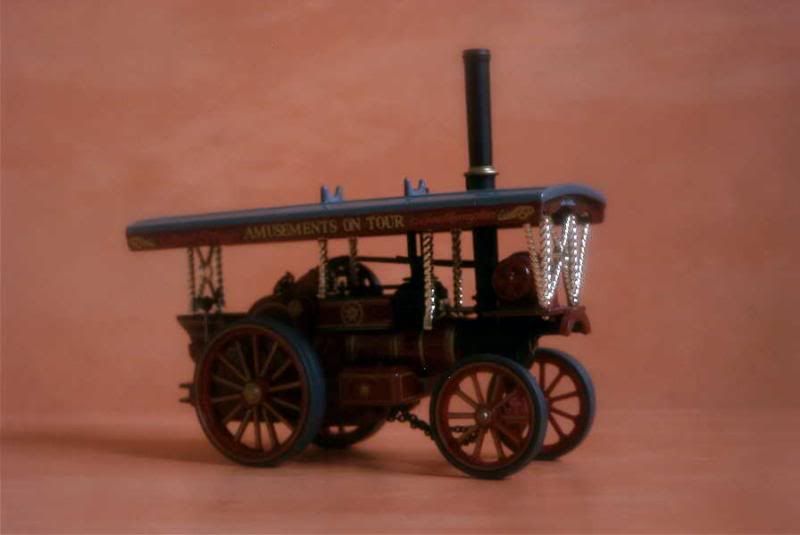
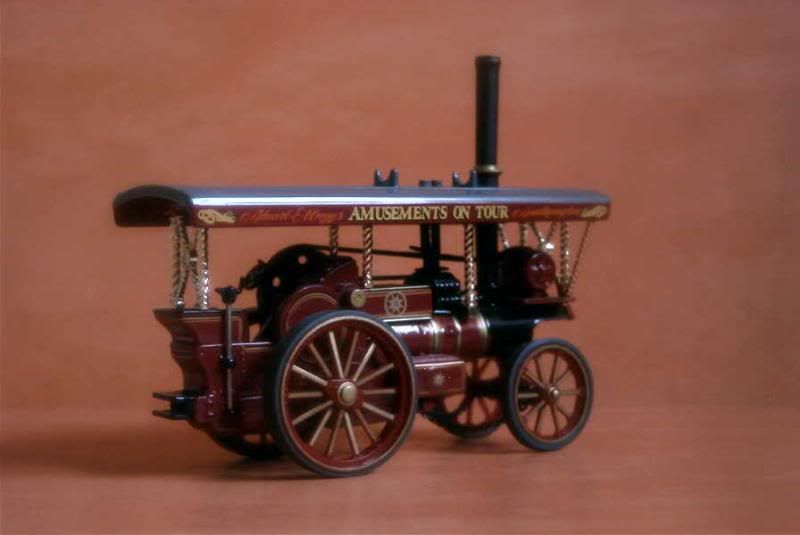
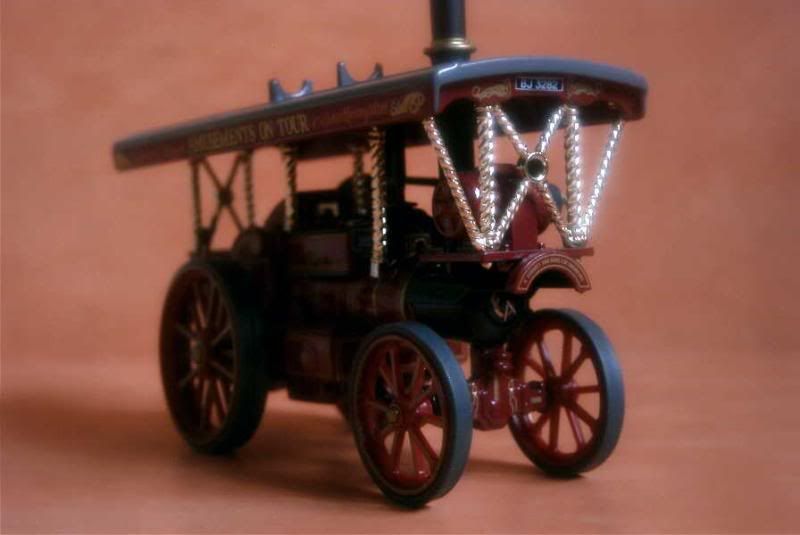
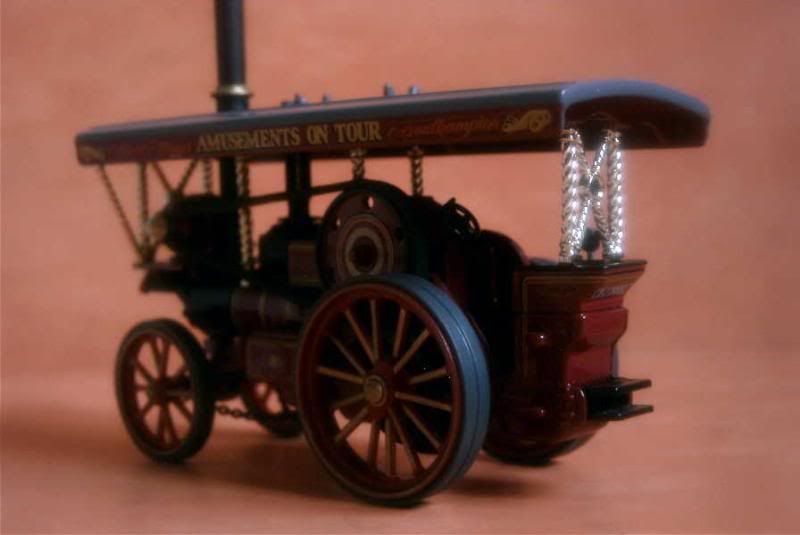
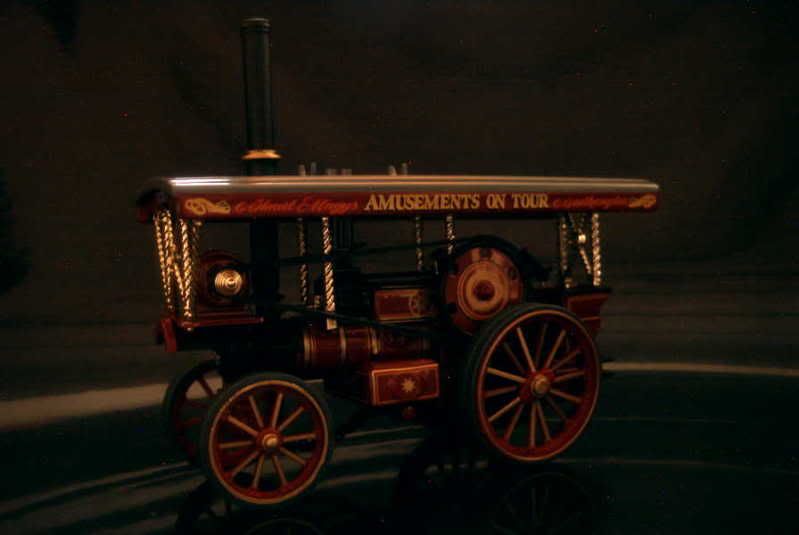
Harnessing the power of steam to alleviate men’s work isn’t a new idea, but it took centuries to make it feasible. Thanks to inventors as Savery, Newcomen or Watt, steam engines were by the late 18th century commonly used by the English industry, most notably to run pump in coal mines. Water accumulating down the tunnels and shafts could now be easily evacuated. Productivity increased. Cheaper coal was purchased by more and more factories which equipped themselves with static steam engines fulfilling various tasks. The Industrial Revolution was in motion.
Completely unknown only a few years before, a totally new market appeared in England for those machines. The Leiston firm Richard Garrett & Sons was among those which grabbed a share of it, starting in 1778 – quite modestly actually, as that year Richard Garrett settled in town and purchased a blacksmith’s forge, but the concern didn’t wait much before turning to what was then high technologies. Much later, steam tractors, steam wagons and other heavy vehicles were added to the range, and by the early 20th century two thousands workers converged every day to the then-imposing factory.
Garrett fulfilled important contracts during World War One, the new form of conflict having shown a serious need for machines able to haul heavy loads. Nevertheless, Garrett ventured into new markets, adding a range of electric commercial vehicles as early as 1916. It could have emerged a prosperous company from the war years. Unfortunately its equipment hadn’t all been sent to the British army – huge quantities of it had been provided to the soldiers of the czar. One revolution later the new power in place in Russia would know nothing about the debts contracted by the old regime – having worked for nought, Garrett was virtually broke. The old company looked for support, and in 1919 joined the Agricultural & General Engineers, a trust set up to regulate the markets of these specialized machines.
Though the hauling capacities of the steam tractors remained exceptional, lighter, cheaper and more convenient gasoline lorries were becoming commonplace. In 1928, Garrett started toying with the idea of building a diesel-engined commercial vehicle but, despite the fact that prototypes were built, no production ensued before the AGE combine collapsed in 1932, victim of the global economic crisis and of ageing technology. Garrett was saved by another specialist of steam traction, albeit on a slightly different scale, locomotive manufacturer Beyer-Peacock. Though the days of the steam tractors were over, Garrett survived until 1985, after being reorganized as the Richard Garrett Engineering Works.
Today, part of the original factory still stands in Leiston, housing a museum entirely devoted to Garrett. Its webpage is here.
About the model
Model: Garrett 4 CD Showman’s
Year: 1918
Maker: Corgi
Scale: 1/50
Distributed by: Corgi, limited edition
Acquired: brand new in a somewhat tired box, in January 2007, in Hong Kong, S.A.R.
I bought this model without knowing much about it. OK, without knowing anything, I admit that. Since then I learned that the 4 CD (for 4 NHP, CompounD engine) was a successful steam tractor of the early 20th century. But what about “Showman’s”? Wikipedia provided me here with the answer:
“A particularly distinctive form of road locomotive was the Showman's engine. These were operated by travelling showmen both to tow fairground equipment and to power it when set up; either directly or by running a generator. These could be highly decorated and formed part of the spectacle of the fair. Some were fitted with a small crane that could be used when assembling the ride.”
Corgi’s heavy die-cast is most probably based on a model still extant (if you’re curious, you can read its complete history here – very interesting indeed – and see a slightly older picture of it there), and did it rather well. All details are perfectly rendered, and the quality of the assembly is beyond any reproach. To make things even better the production run is very limited. Obviously I would have preferred a 1:43 scale model, but the choice of 1:50, the standard for lorries, is understandable. I’d give a 16/20 rating to this model.








2 comments:
I love this Garrett and everything classic! love the details also! :-)
Thanks a lot JD! This model isn't exactly what I'm used to collect (well, I purchase more or less any type of vehicles, but I have priorities), but I came to appreciate it for its originality and very fine details, you're right about that. The wheels in particular are superb.
Post a Comment